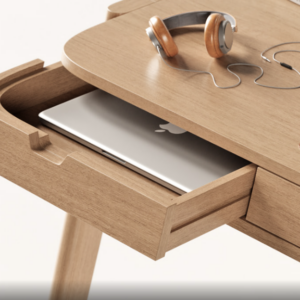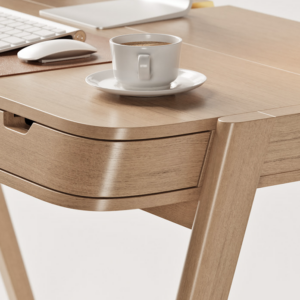I recently came across a desk design I found quite beautiful and interesting. It has a set of curved drawers that looked stunning. I tried to imagine how I would go about duplicating this and could not for the life of me think of how it could be done. As the attached images show, the complexity is not in the curve itself but in the fact that the curve is also slanted and the drawer face is matched to the drawer itself. Would love to get the forum’s thoughts on this one.
Thanks!
















Replies
It’s made using a bent lamination.
Probably true but that doesn't account for the complexity of the angled face. It is a very intriguing design meets construction reality problem.
And then the edges are veneered?
Thanks!
Laminate bending doesn't require veneer edge especially in straight grained wood such as used in this table. Properly done the laminates would be very difficult to discern.
On quick analysis the only thing I can come up with is you would need to form the drawer face oversized then rip it to size on a bandsaw with the face riding on the table. If you ripped the top edge first you could get a straight edge without the angled arm interfering with the fence then come back and guide the top edge against the fence for additional support in ripping the bottom parallel.
The pictures don't have enough detail to see if they are laminate bent but I would think they would have to be, wood bending is one of my bucket list items as of yet unfulfilled so I don't claim to be an expert in that aspect.
Looks like bent lamination and then a show veneer added to the face and top edge. The grain has an angle to it because of the bias from veneering the canted corner. There will be alot of forms to make because left and right are not the same. I guess I would start by making a form the exact size of the drawer w/o the face on it and then add 2 layers of mdf above and below to form the oversized blank for the face. Keep the layers thin to avoid springback and use a hard-line glue like Unibond to eliminate long-term creep. Lastly, I think I'd wait until the drawers were done to cut the finished curves on the tabletop and bottom.
I would definitely make extras in lesser materials to test setups at every turn.
Cool project!
It is going to be interesting giving it a try! Thanks!
I think it can be done with large form since the back has the same design. You could then cut the front into the 3 separate pieces.
You can all see more photo. He's a talented designer.
https://www.behance.net/gallery/96450231/Shelter-%282020%29
That looks to be quite a challenging project with 4 of those corners plus the curves seem to be in the drawer boxes as well. I can imagine it took a few prototypes for him to refine that design.
Sorry, but that smacks of CAD designed, lazer cut, CNC built ,laminated over mdf. No humans involved.. There are shops( factories ) that you can send your design and for a few g's and in a few days deliver you a finished prototype. Them you find a buyer/ manufacturer like Mayfair/ Elm West and your golden. Or, your already established and contracted to a manufacture and they take care of the bills. My son was in that business. Started with a furniture company, went on to project based learning, then satellites, then VR and now I don't know what but he gets paid pretty good to stay at home. He has demonstrated to me what these machines are capable of. I was doing a really complicated project with lots of angles and days making jigs and patterns and making corrections for inaccuracies. He took the whole project and in a couple of hours had all the parts. Then he said "Now that you've done it you just decided that proportionally it needs to 1/2" bigger. That would be square one for me, he had all the new parts in 15 minutes! It's a really different bag than what I do
I was thinking the exact same thing. He is most likely just a designer and not a builder. I know a CNC can knock something like this out pretty quickly. I just love the joy of saying I designed something and then actually building it. I would call myself an intermediate level woodworker and the drawers on this thing are a little out of my capabilities right now. I have another design I was working on that a drawer such as this would look great on. I was just really curious how it was done. I'm sure he is designing with potential mass manufacture in mind and not as a one off. Thanks for your thoughts though!
Agree with Pants -- this desk (and matching chair) seem to come from a production shop. That being said, it's a very nice and pleasing design.
Look at Shelter's bench with shoe rack. That convinced me Pantalones868 is right.
Agree. He is using some custom collars on those dowels that recess into half round pockets that would require some sort of custom tooling (I think). He is also using cam locks to secure it so it looks like it's designed to be flat packed.
No one ever said the guy was a builder!
Most likely not:)
Production shops can build to verry high standards and this seems to be the case with great designs such as in this case. As for the laminated drawer fronts, They remind me of the half circle table aprons we used on « production » built round tables. They were laminated 2 or 3 foot wide and then sliced into 4 inches wide aprons on the table saw. In this case this would only waste the ends because the angle.
Bent laminated from solid wood strips and veneered, or built up from MDF, bandsawn and then veneered. Most likely the latter.
The design is nice though. Modern materials and machinery make these designs commercially feasible and there's not a thing wrong with it. A lot of people can manipulate tools, far fewer can design (though many think they can).
I agree. Hard to imagine a wood that can stretch and bend around a compound curve like that and still maintain a constant horizontal grain pattern across the entire front of the drawer.
Exactly what I was wondering
Do not discount the use of 3D printers.I think the age of the craftsman is drawing to a close and the era of the designer/computer geek is rapidly approaching.
I wonder if those images are not actually photos - looking at them closely they may be computer-generated. See attached image taken from an Adobe email I got recently. The desk may never have been built! That grain pattern looks nearly impossible to me...
This forum post is now archived. Commenting has been disabled